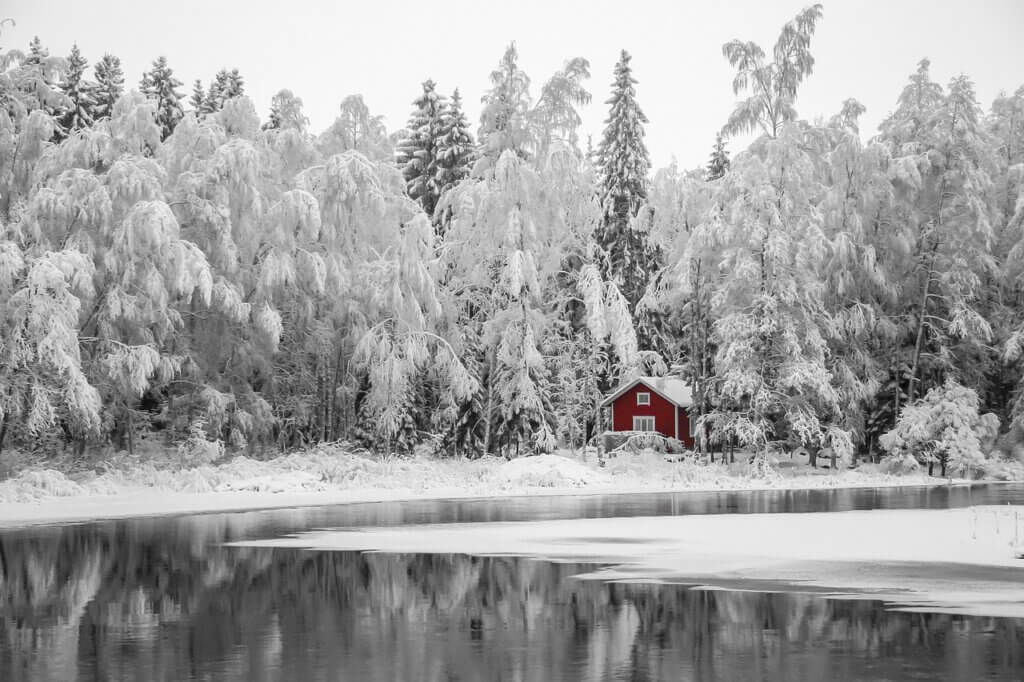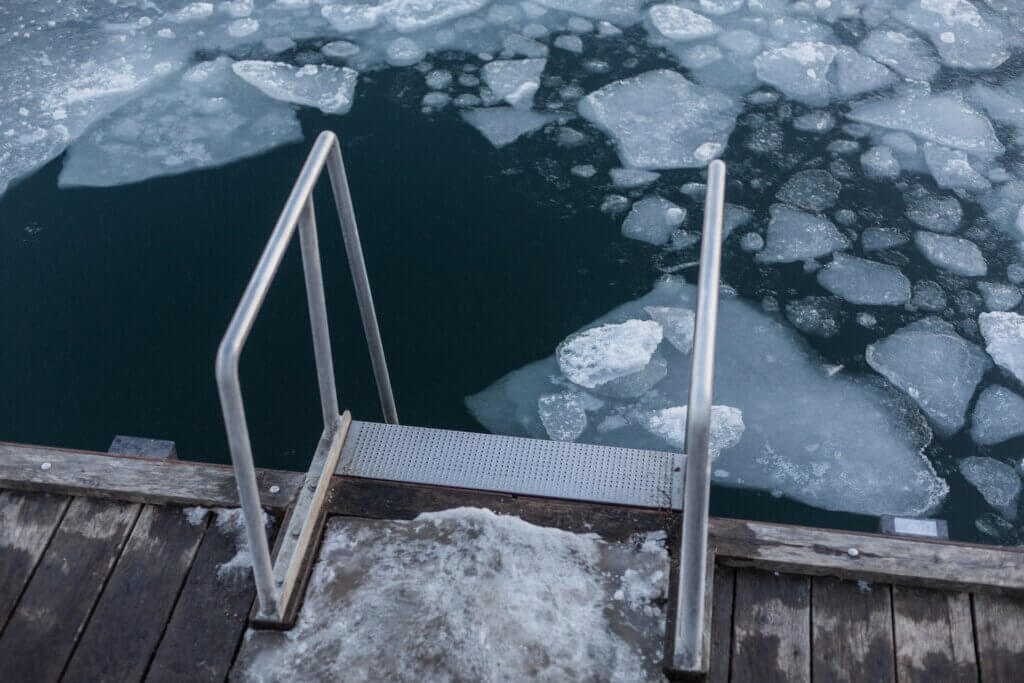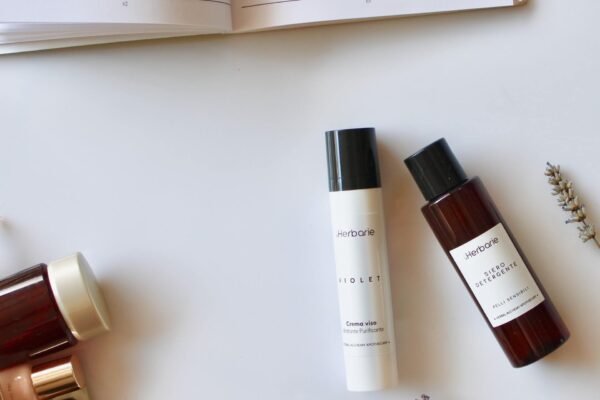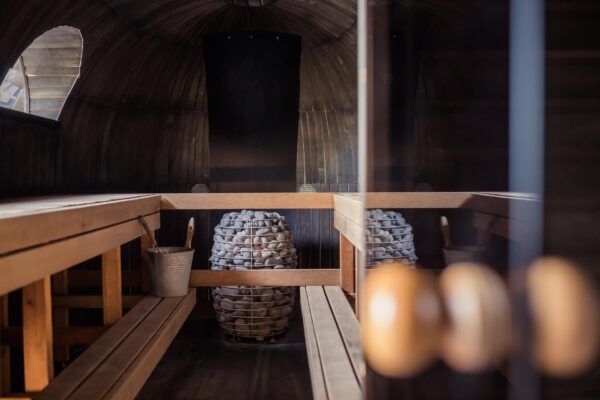While some people might get a cold shock just watching it, ice bathing has become a firm tradition for many – especially in Scandinavia, going for a dip in the ice-cold water is simply a must. Here you can find out everything you need to know about the health trend from the north.
What is an ice bath and what are the benefits?
Ice bathing (also known as cold bathing or winter bathing) is, simply put, self-explanatory: you bathe in ice-cold water, in the best (and Scandinavian) case by sawing a hole in the ice. Accordingly, it is of course mainly practised in winter and in cold regions. Important to note: When ice bathing, you stay on one spot – under no circumstances should you swim.
Ice bathing is widespread in many cultures – including Scandinavia, where it is particularly popular. Winters in Scandinavia are long, cold, snowy and icy, which is why there are many opportunities to jump into ice-cold water in the great outdoors.
However, the reason why ice bathing is so popular in Scandinavia is not just the long winter. In Finland and Sweden in particular, the sauna has a long tradition – and a good sauna session also involves jumping into the cold water afterwards. There are numerous lakes in both countries that invite you to do so, which is why many saunas are located directly on the water or are sometimes even built directly on the lake and have direct access to the icy water. Finland even has its own term for this combination of extreme heat and extreme cold: avanto.

Are ice baths healthy?
Ice bathing can actually have a positive effect on the body and health. For example, the cold water can promote and improve blood circulation, as the blood vessels constrict and dilate quickly. The immune system can also be strengthened with regular ice bathing, as the production of white blood cells is stimulated. With a stronger immune system, the body is at best better protected against infections. The cardiovascular system can also be strengthened.
Especially if you do a lot of intensive sport, ice bathing can help to reduce muscle pain, as cold has anti-inflammatory properties. The cold can also stimulate fat burning. You can also increase your pain and cold tolerance.
But ice bathing doesn’t just have an impact on your physical health – it can also boost your mental health. The challenge and overcoming the cold can give you a sense of achievement. It can also contribute to the release of endorphins, leading to an improved mood and a sense of well-being.
Ice baths: dangers and risks
Ice bathing harbours a number of dangers and risks, and not just for beginners. It is therefore very important to only practise ice bathing in a safe environment and under supervision. Preparation is essential, as you may be exposing yourself to life-threatening conditions.
One of the greatest (and most obvious) dangers is hypothermia. That’s why you should never stay in the water for long, but get back into dry land after just a few minutes. In the worst case scenario, you could suffer frostbite, which can cause long-term damage to your health.
Ice bathing can also lead to cardiovascular problems if your cardiovascular system is not strong and fit enough. You also run the risk of breathing difficulties, muscle cramps or general weakness and disorientation – ice bathing is an extreme situation because you don’t just get used to the cold.
Instructions: how to prepare for an ice bath
It is not advisable to simply go ice bathing without any preparation – as described above, there are some dangers and risks, even for experienced ice bathers. It is therefore important to prepare yourself, ideally long before the first ice bath.
Step 1: health check
The risks are there – it may be that your body is simply not (yet) made for getting into ice-cold water. Healthy circulation and fitness are very important if you want to be strong enough to withstand the cold. In the best case scenario, you should therefore have a check-up with your trusted doctor.
Step 2: get your body used to the cold
To avoid a cold shock, you should gently acclimatise your body to cold water. You can do this on your own and even integrate it into your daily routine. A good way to do this, for example, is to gradually stop using hot water in the shower and shower colder each time. You can also practise using a bathtub – simply add more and more ice cubes to the cold water. You can also practise your breathing at the same time.
It is essential that you approach the cold very slowly or at your own pace and listen to your body.

Step 3: the right equipment
Swimsuit on and right into the water? Better not. As a beginner, you should wear a wetsuit for the first few baths to protect your body and retain heat. You may also want to buy neoprene socks to protect your feet. As not only your feet but also your hands and head give off heat quickly, you should also wear gloves and a hat when swimming.
Step 4: find like-minded people
Under no circumstances should you go ice swimming alone – the risks are simply too high. What’s more, the first step is difficult, as it requires not only physical fitness but also mental strength. In a group or with a trainer, it is often easier to overcome your inhibitions and motivate yourself to keep going.
Step 5: get out into nature
If you have outdoor pools, natural pools or other safe bodies of water nearby where you can swim outside of the summer months, these are ideal for carefully getting used to the natural cold. You can also experience the falling temperatures of autumn and winter in a natural way.
Step 6: make sure you breathe correctly
With the right breathing techniques, you can relax, increase your body heat and prepare yourself for the cold. Take time to relax your body before going into the bath. It is also important to breathe properly in the water and not to fall into hectic breathing – it is very important to practise this. The well-known Wim Hof method uses a special breathing technique: inhale and exhale 30-40 times, then hold your breath for one minute.
Step 7: off into the ice!
If you feel ready and fit, nothing stands in the way of your first ice bath. It’s best to get your towels and clothes ready so that you can quickly change back into dry clothes after going into the ice. Perhaps also take a thermos flask of tea or another warm drink with you.
For your first bath, you should get into the water slowly. It shouldn’t take longer than a few minutes, preferably only up to three minutes. This is perfectly fine and completely normal, as the body is in an extreme situation even after a long period of preparation. You should also be careful not to dunk your head.
Once you are out of the water, you should warm up slowly and stimulate your circulation, for example by doing the Horse Stance. Then dry off and put on plenty of clothes so that your body is well protected. Warm drinks are also beneficial – and a little reward for all the effort!
Step 8: create a routine
If you like it, you should develop a routine, as this is the only way to really get used to ice bathing. Over time, you will create a sense of normality and your inhibitions will decrease.
Where can you go ice swimming?
Can you go ice bathing at home in the UK?
You don’t have to go to northern Europe to go ice swimming – even if it is a completely different experience up there in the north. Instead, you can dare to take a dip in the ice-cold water at home. Not only the bathtub is suitable for this, but also rain barrels or special ice barrels and baths that you can easily set up – the best thing is if you have a garden or a well-protected balcony, since you are outdoors and get the full experience.
The tubs are usually made of plastic or wood, but inflatable tubs are now also in vogue, which are easy to transport and set up and take down. For people with a higher budget, freezers or special IBC tanks are available.
In general, however, you can use various containers for ice bathing, and there are virtually no limits to your creativity. For example, rubbish bins can also be used as ice bath containers.
Ice bathing outdoors – where and how do you find the spots?
There are ice bathing spots and groups that regularly go ice bathing in a wide variety of places and in many cities. The best place is of course a suitable natural swimming spot, such as a lake or a secluded river or stream – but you should always make sure that swimming is actually permitted.
It’s best you check out ice bath communities and groups online.
In a nutshell: the most important questions about ice bathing
Ice bathing not only provides an adrenaline rush, but can also have positive effects on the body and mind. Not only can the immune system, blood circulation and circulation be strengthened and promoted, but also mental health. Ice bathing also has benefits for athletes in particular: It can help with muscle pain and boost fat burning.
Ice bathing is not about competition, but about your own body awareness. Just a few minutes are enough – especially as a beginner, you should never stay in the water for longer than five minutes, two to three minutes is often enough.
At temperatures below zero, you should only stay in the water for a few seconds.
If you want to benefit from ice bathing, you should quickly build up a routine and go ice bathing as often as possible. This will get you used to the cold water and toughen you up. Ideally, you should go ice bathing once or twice a week, but you can also go more often – but you should also give your body a day’s rest between baths.
In addition to the benefits, ice bathing also harbours dangers – it is and remains an extreme situation. Hypothermia and frostbite are obvious risks, and it can also lead to cardiovascular problems, breathing difficulties or muscle cramps. You should therefore prepare yourself well, ideally get a medical check-up and, above all, never go ice swimming alone!
In the morning, ice bathing provides a fresh start to the day – the endorphins released ensure a good mood and motivation. In the evening, ice bathing can have a relaxing effect, especially after a stressful working day. It can also help you fall asleep more easily.

